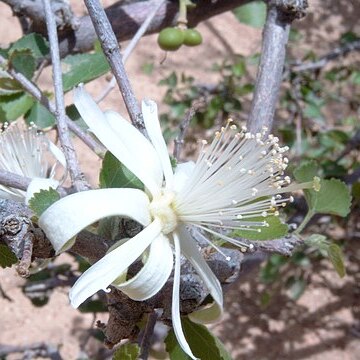Small shrub up to 2 m tall, branches glabrescent. Leaf-blade up to 30 x 20 mm, orbicular to obovate, broadly rounded at the apex, rounded or abruptly cuneate at the base, rather coarsely dentate, slightly scabrous-pubescent with tufted hairs, especially below, or glabrescent; greyish green, coriaceous; petiole up to 10 mm long but usually much less, pubescent with tufted hairs; stipules up to 4 mm long, filiform, pubescent. Flowers always borne singly, leaf-opposed; peduncles about 10 mm long, almost glabrous, slender; pedicels similar, up to 10 mm long, the whole giving the appearance of an articulated pedicel; bracts about 1.5 mm long, glabrescent. Sepals greenish, 10-18 mm long, shortly pubescent outside, white and glabrous inside, linear-oblong. Petals white with a linear and often bidentate lamina almost as long as the sepals and narrower than the basal nectariferous claw which is circumvillous within, ledged above and up to 1.5 mm tall. Androgynophore with a basal glabrous portion up to 1.5 mm tall and a closely pubescent upper portion up to 1.5 mm tall. Ovary 4-lobed, glabrous or glabrescent; style about 10 mm long, glabrous; stigma-lobes broad. Fruit about 10 mm in diam., 4-lobed, shining, glabrous.
A shrub. It grows up to 2 m tall. Often it lies along the ground. The leaves are small and nearly round. They are 5 cm long. They have 5 main veins. The tip of the leaf is pointed and the edge has teeth. The lower leaf surface has hairs. The flowers are white and occur singly. They are 2 cm across. They are on long slender branches. The fruit are orange red and smooth. They have 1-4 lobes. They are the size of a small maize grain. They are edible.
Leaf-lamina up to 3 × 2 cm., orbicular to obovate, rounded at the apex, margin rather coarsely dentate, rounded or abruptly cuneate at the base, slightly scabrous-pubescent especially below, or glabrescent, greyish-green, coriaceous; petiole up to 1 cm. long, but usually much less, pubescent; stipules up to 4 mm. long, filiform, pubescent.
Flowers always borne singly, leaf-opposed; peduncles c. 10 mm. long, almost glabrous, slender; pedicels similar, up to 10 mm. long, the whole giving the appearance of an articulated pedicel; bracts minute, glabrescent, c. 1·5 mm. long.
Petals white, with a linear and often 2-dentate lamina almost as long as the sepals and narrower than the basal nectariferous claw which is circumvillous within ledged above and up to 1·5 mm. long.
Shrub, 2 m high. Leaves orbicular to obovate. Flowers always borne singly, leaf-opposed. Fruit 4-lobed, 10 mm in diameter, shining. Flowers white.
Androgynophore with a basal glabrous portion up to 1·5 mm. long and a densely pubescent upper portion up to 1·5 mm. long.
Sepals 10–18 mm. long, greenish and shortly pubescent outside, white and glabrous inside, linear-oblong.
Ovary 4-lobed, glabrous or glabrescent; style c. 10 mm. long, glabrous; stigma-lobes broad.
Fruit c. 10 mm. in diam., 4-lobed, shining, glabrous.
Small shrub up to 2 m. tall; branches glabrescent.
Shrub, to 10 ft. high
Fruits reddish.
Flowers white


